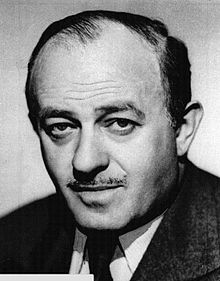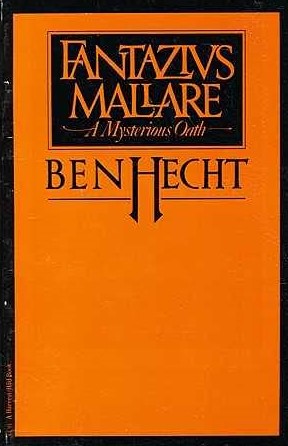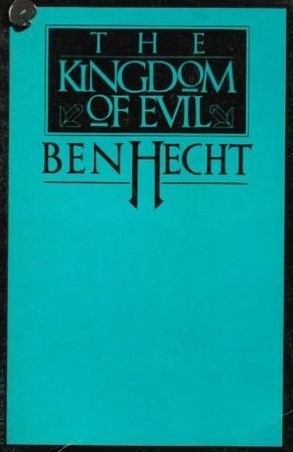 The 1922 novella FANTAZIUS MALLARE: A MYSTERIOUS OATH attained a fair amount of infamy in its day. Most of the initial shock value has obviously worn off, but FANTAZIUS MALLARE’S subject matter, at least, is still quite eye-opening. The same holds true for its 1924 sequel THE KINGDOM OF EVIL.
The 1922 novella FANTAZIUS MALLARE: A MYSTERIOUS OATH attained a fair amount of infamy in its day. Most of the initial shock value has obviously worn off, but FANTAZIUS MALLARE’S subject matter, at least, is still quite eye-opening. The same holds true for its 1924 sequel THE KINGDOM OF EVIL.
BEN HECHT (1893-1964) was a famous newspaperman, screenwriter and political activist. Hecht authored 35 books and was credited with over 70 screenplays, so it’s hardly inconceivable that FANTAZIUS MALLARE is largely forgotten nowadays; in his celebrated 1954 autobiography A CHILD OF THE CENTURY the novel receives but a few paragraphs of coverage (THE KINGDOM OF EVIL isn’t mentioned at all), while many Hecht bios tend to ignore it altogether.
Hecht’s mainstream credentials were impeccable. He won the first-ever Academy Award for best screenplay, contributed to the scripts of beloved classics like WUTHERING HEIGHTS and GONE WITH THE WIND, and ghostwrote the autobiography of Marilyn Monroe. Yet he had a taste for irreverence, being one of Hollywood’s infamous Bundy Drive Boys (whose ranks included Errol Flynn and W.C. Fields, and who, according to Gregory William Mank’s indispensable volume HOLLYWOOD’S HELLFIRE CLUB, “made the Rat Pack look like Cub Scouts”) and the author of A JEW IN LOVE, wherein Hecht claimed that “If I’d had charge of executing Christ, I’d…have had him shipped to Rome and fed to the lions. They could never make a savior out of mincemeat!”
It’s that side of Hecht on display in FANTAZIUS MALLARE. Inspired by Joris-Karl Huysmans’ 1884 novel A REBOURS (known in English as AGAISNT THE GRAIN and AGAINST NATURE), about a wealthy misanthrope who retreats into a private reality, FANTAZIUS MALLARE is the depraved tale of a dour, suicidal freak. Mallare (who appears to have been at least partially inspired by Hecht’s fellow Bundy Drive Boy John Barrymore, a.k.a. “the Monster”) takes to making lengthy notations in his journals about the nature of reality and the essential worthlessness of mankind.
AGAISNT THE GRAIN and AGAINST NATURE), about a wealthy misanthrope who retreats into a private reality, FANTAZIUS MALLARE is the depraved tale of a dour, suicidal freak. Mallare (who appears to have been at least partially inspired by Hecht’s fellow Bundy Drive Boy John Barrymore, a.k.a. “the Monster”) takes to making lengthy notations in his journals about the nature of reality and the essential worthlessness of mankind.
Despite his overwhelming misanthropy, Mallare decides he needs a woman in his life. He chooses a strange gypsy girl named Rita, who Mallare becomes determined to dominate body and soul. Rita in turn develops a masochistic attraction to Mallare, especially after he comes to falsely believe he’s killed her, and so thinks she’s a ghost to whom he can do anything he wants. The result is a uniquely depraved evocation of madness, hallucination and transgression, marred only by a few too many misanthropic ramblings and much excess philosophizing on the part of the naval-gazing protagonist.
The novel is especially notable for its opening dedication, which begins thusly: “This dark and wayward book is affectionately dedicated to my enemies–to the curious ones who take fanatic pride in disliking me…” This dedication, which might have come from the pen of Fantazius Mallare himself, goes on for another seven pages(!), taking into account “the moral ones who have relentlessly chased God out of their bedrooms” and “the cowardly ones who borrow their courage from Ideals which they forthwith defend with their useless lives,” as well as “the psychopathic ones who seek to vindicate their own sexual impotencies by padlocking the national vagina.”
FANTAZIUS MALLARE was circulated in a limited edition 2,000 copy hardcover, which contained highly Aubrey Beardsley-esque black-and-white illustrations by Wallace Smith. The book was quickly confiscated by the Federal Government, which branded it “lewd, obscene and lascivious” and further charged Hecht with “defiling the U.S.A. mails with its transport” (apparently the one element that truly upset censors was the use of the word “pissing”). The eminent Clarence Darrow succeeded in winning an acquittal for Hecht, who (as claimed by Gregory William Mank) found himself “loving every minute” of the 1922 legal proceedings.
 Ben Hecht followed FANTAZIUS MALLARE with THE KINGDOM OF EVIL in 1924. This new novel was again profusely illustrated, this time by Anthony Angarola, and sold as a limited edition hardcover. As for the prose, it gives credence to the oft-repeated claim that Hecht could write in any style. Whereas FANTAZIUS MALLARE was patterned after the French decadents, THE KINDGDOM OF EVIL is more in line with the Weird Tales style of H.P. Lovecraft et al in its evocation of a nightmarish realm of otherworldly creatures.
Ben Hecht followed FANTAZIUS MALLARE with THE KINGDOM OF EVIL in 1924. This new novel was again profusely illustrated, this time by Anthony Angarola, and sold as a limited edition hardcover. As for the prose, it gives credence to the oft-repeated claim that Hecht could write in any style. Whereas FANTAZIUS MALLARE was patterned after the French decadents, THE KINDGDOM OF EVIL is more in line with the Weird Tales style of H.P. Lovecraft et al in its evocation of a nightmarish realm of otherworldly creatures.
Here Mallare shuns reality altogether to retreat into a bizarre psychological netherworld. Therein he’s kidnapped, and put to work in a subterranean sweatshop manned by a freak who’s looking to create a vast kingdom of evil, filled with structures resembling “warehouse ectoplasms.” Yet this isn’t enough, and before long Mallare and his fellow slaves construct a God to rule the kingdom of evil. Their initial attempts at creating this deity result in a variety of hideous monstrosities, the fecund descriptions of which are right out of Clark Ashton Smith: “Around us in every direction were dreadful, nauseating creatures…a convulsive debris of faces, limbs and fetal distortions moving like foul bags of life.”
Eventually a God is created, a monstrous personage that grows to an incalculable size—until it’s killed and the kingdom is overrun by an army of homicidal mannequins. By this point Mallare becomes overwhelmed by the details of his imagined universe, whose inhabitants come to realize they’re figments of his imagination and grow upset with him, leading to a suitably horrific finale.
As far as I know, THE KINGDOM OF EVIL never attained a shade of the controversy of its predecessor, or much attention of any sort. It is worthy, however, as both a continuation of Mallare’s insane exploits and a standalone exercise in gothic surrealism. It’s a shame Hecht did little else in the horror/fantasy genres, as the decadent sexuality of FANTAZIUS MALLARE and macabre invention of THE KINGDOM OF EVIL show he had a definite talent for such fare.*
*FANTAZIUS MALLARE is currently available in a variety of forms, but the one to read (outside the initial 1922 hardcover, which is neither common nor cheap) is the 1978 HBJ trade paperback, which reproduces the unique formatting and illustrations of the original publication. Ditto HBJ’s 1978 reprinting of THE KINGDOM OF EVIL.
